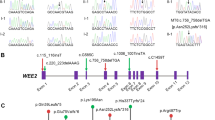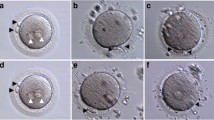Abstract
Purpose
To identify the disease-causing gene in a family with female infertility and fertilization failure.
Methods
Whole-exome sequencing and Sanger sequencing were used to identify the disease-causing gene in a female with infertility and fertilization failure. Subcellular localization and western blot analysis were used to check the effect of mutations.
Results
We identified novel compound heterozygous mutations c.598C>T (p.Arg200Ter) and c.1319G>C (p.Trp440Ser) in WEE2 gene in a female with infertility and fertilization failure. The p.Arg200Ter mutant WEE2 gene produce truncated protein and mainly located in the nucleus, the same as the wild protein, while the p.Trp440Ser mutant WEE2 proteins are located in the nucleus and cytoplasm and the expression level of p.Trp440Ser mutant WEE2 protein is reduced significantly compared with that of wild-type WEE2.
Conclusions
We discovered novel compound heterozygous mutations c.598C>T (p.Arg200Ter) and c.1319G>C (p.Trp440Ser) in WEE2 gene in a female whose oocytes could not form pronucleus after intracytoplasmic sperm injection (ICSI). Moreover, mutations in WEE2 gene affect the normal function of WEE2 proteins and cause fertilization failure.



Similar content being viewed by others
References
Usadi RS, Merriam KS. On-label and off-label drug use in the treatment of female infertility. Fertil Steril. 2015;103:583–94.
Conforti A, Mascia M, Cioffi G, De Angelis C, Coppola G, De Rosa P, et al. Air pollution and female fertility: a systematic review of literature. Reprod Biol Endocrinol. 2018;16:117.
Hanson B, Johnstone E, Dorais J, Silver B, Peterson CM, Hotaling J. Female infertility, infertility-associated diagnoses, and comorbidities: a review. J Assist Reprod Genet. 2017;34:167–77.
Huang HL, Lv C, Zhao YC, Li W, He XM, Li P, et al. Mutant ZP1 in familial infertility. N Engl J Med. 2014;370:1220–6.
Zou Y, Zhou JY, Guo JB, Zhang ZY, Luo Y, Liu FY, et al. Mutation analysis of ZP1, ZP2, ZP3 and ZP4 genes in 152 Han Chinese samples with ovarian endometriosis. Mutat Res. 2019;813:46–50.
Zhou Z, Ni C, Wu L, Chen B, Xu Y, Zhang Z, et al. Novel mutations in ZP1, ZP2, and ZP3 cause female infertility due to abnormal zona pellucida formation. Hum Genet. 2019;138:327–37.
Alazami AM, Awad SM, Coskun S, Al-Hassan S, Hijazi H, Abdulwahab FM, et al. TLE6 mutation causes the earliest known human embryonic lethality. Genome Biol. 2015;16:240.
Feng R, Sang Q, Kuang Y, Sun X, Yan Z, Zhang S, et al. Mutations in TUBB8 and human oocyte meiotic arrest. N Engl J Med. 2016;374:223–32.
Xu Y, Shi Y, Fu J, Yu M, Feng R, Sang Q, et al. Mutations in PADI6 cause female infertility characterized by early embryonic arrest. Am J Hum Genet. 2016;99:744–52.
Maddirevula S, Coskun S, Alhassan S, Elnour A, Alsaif HS, Ibrahim N, et al. Female infertility caused by mutations in the oocyte-specific translational repressor PATL2. Am J Hum Genet. 2017;101:603–8.
Chen B, Zhang Z, Sun X, Kuang Y, Mao X, Wang X, et al. Biallelic mutations in PATL2 cause female infertility characterized by oocyte maturation arrest. Am J Hum Genet. 2017;101:609–15.
Sang Q, Li B, Kuang Y, Wang X, Zhang Z, Chen B, et al. Homozygous mutations in WEE2 cause fertilization failure and female infertility. Am J Hum Genet. 2018;102:649–57.
Mu J, Wang W, Chen B, Wu L, Li B, Mao X, et al. Mutations in NLRP2 and NLRP5 cause female infertility characterised by early embryonic arrest. J Genet. 2019;56:471–80. https://doi.org/10.1136/jmedgenet-2018-105936.
Sang Q, Zhang Z, Shi J, Sun X, Li B, Yan Z, et al. A pannexin 1 channelopathy causes human oocyte death. Sci Transl Med. 2019;11(485):eaav8731.
Zhao S, Chen T, Yu M, Bian Y, Cao Y, Ning Y, et al. Novel WEE2 gene variants identified in patients with fertilization failure and female infertility. Fertil Steril. 2019;111:519–26.
Han SJ, Conti M. New pathways from PKA to the Cdc2/cyclin B complex in oocytes: Wee1B as a potential PKA substrate. Cell Cycle. 2006;5:227–31.
Dai J, Zheng W, Dai C, Guo J, Lu C, Gong F, et al. New biallelic mutations in WEE2: expanding the spectrum of mutations that cause fertilization failure or poor fertilization. Fertil Steril. 2019;111:510–8.
Yang X, Shu L, Cai L, Sun X, Cui Y, Liu J. Homozygous missense mutation Arg207Cys in the WEE2 gene causes female infertility and fertilization failure. J Assist Reprod Genet. 2019. https://doi.org/10.1007/s10815-019-01418-9.
Zhang Z, Mu J, Zhao J, Zhou Z, Chen B, Wu L, et al. Novel mutations in WEE2: expanding the spectrum of mutations responsible for human fertilization failure. Clin Genet. 2019;95:520–4.
Oh JS, Susor A, Conti M. Protein tyrosine kinase Wee1B is essential for metaphase II exit in mouse oocytes. Science. 2011;332:462–5.
Acknowledgments
We thank Lei Wang and Qing Sang in Fudan University for their gift of WEE2 plasmid and the family members for their enthusiastic participation in this study.
Funding
This work was supported by grants from the National Natural Science Foundation of China (81000079, 81170165, 81870959 to X.Z.) and supported by Program for HUST Academic Frontier Youth Team.
Author information
Authors and Affiliations
Corresponding authors
Ethics declarations
This study was approved by the ethics committee of Huazhong University of Science and Technology. All participants in the study agreed with informed consent to participate in the investigation.
Competing interests
The authors declare that they have no competing interests.
Additional information
Publisher’s note
Springer Nature remains neutral with regard to jurisdictional claims in published maps and institutional affiliations.
Rights and permissions
About this article
Cite this article
Zhou, X., Zhu, L., Hou, M. et al. Novel compound heterozygous mutations in WEE2 causes female infertility and fertilization failure. J Assist Reprod Genet 36, 1957–1962 (2019). https://doi.org/10.1007/s10815-019-01553-3
Received:
Accepted:
Published:
Issue Date:
DOI: https://doi.org/10.1007/s10815-019-01553-3




